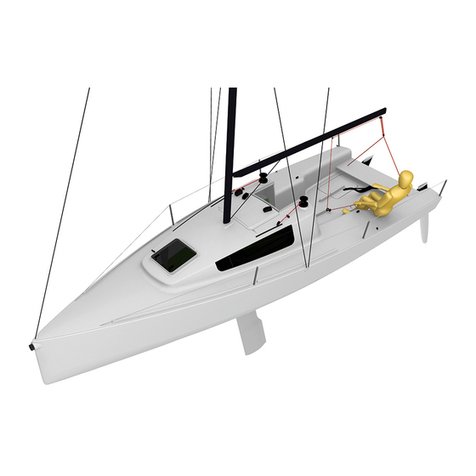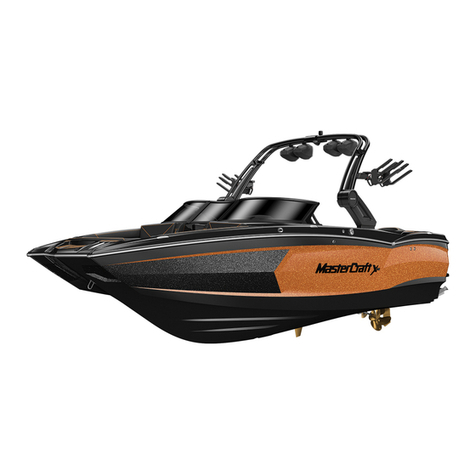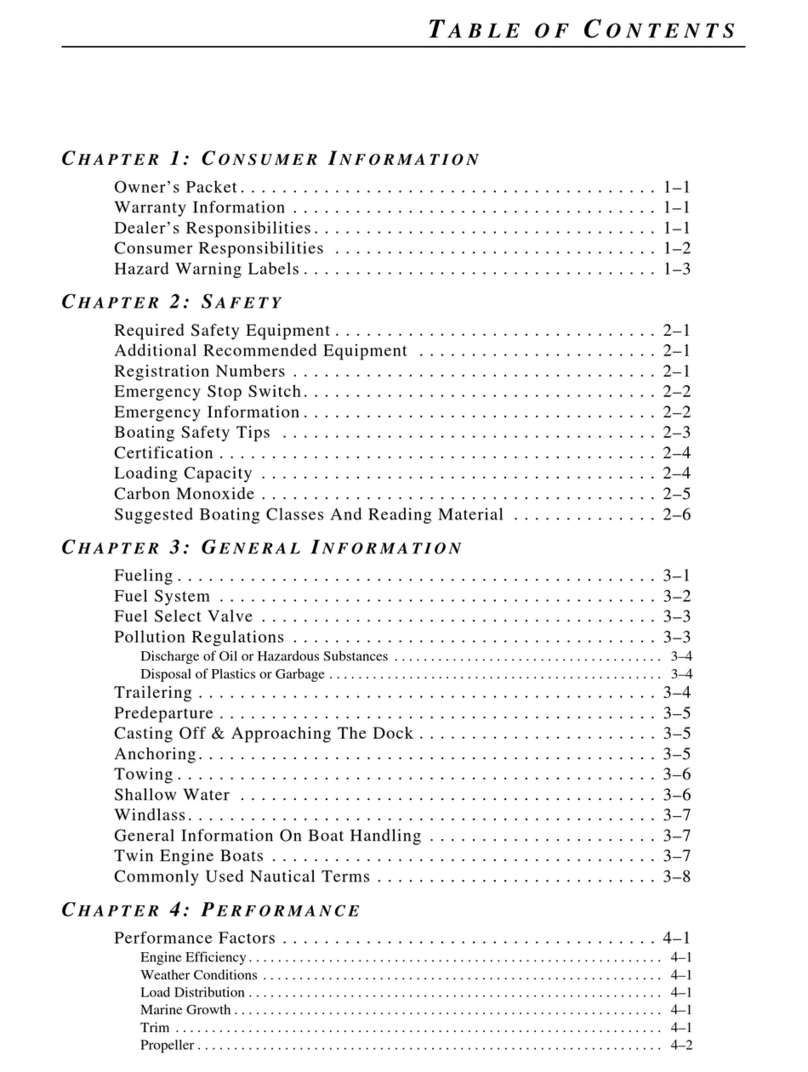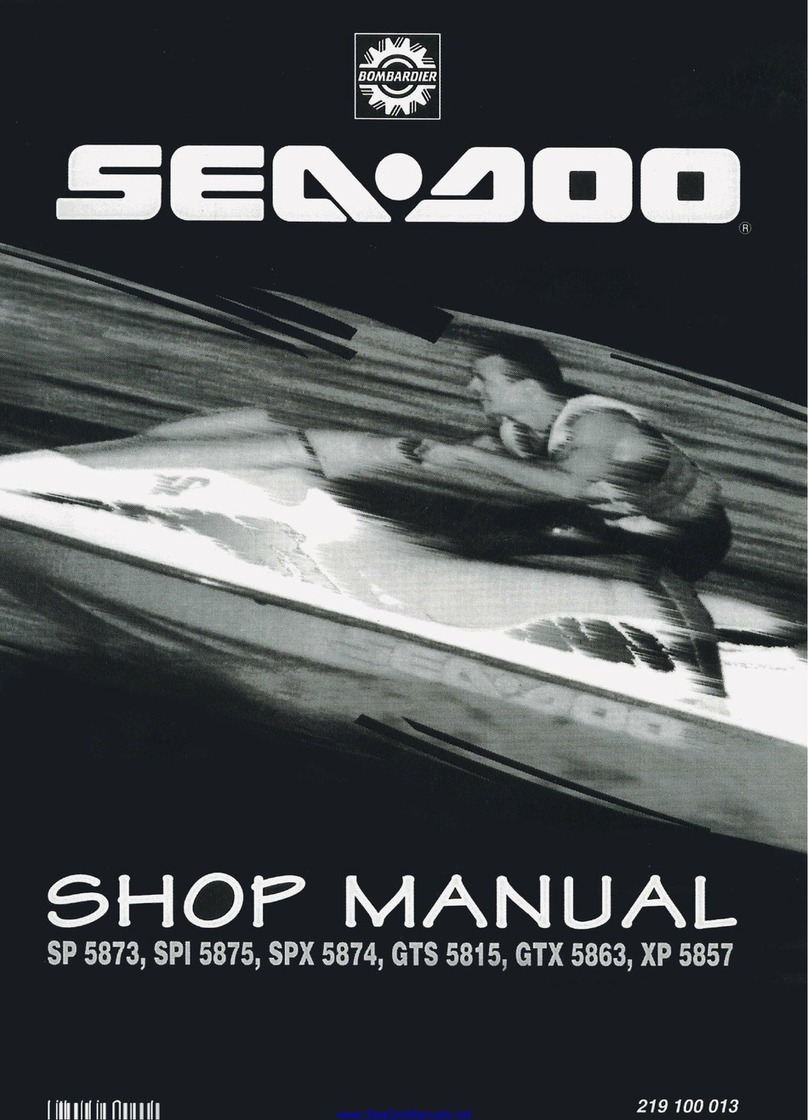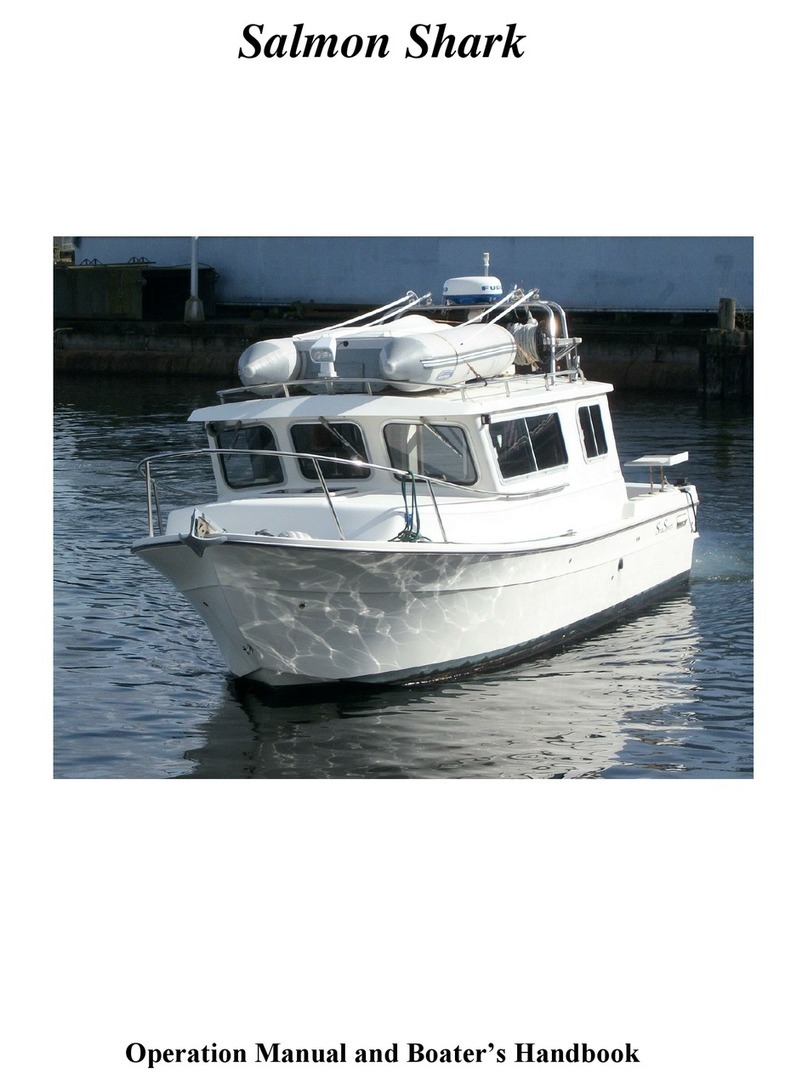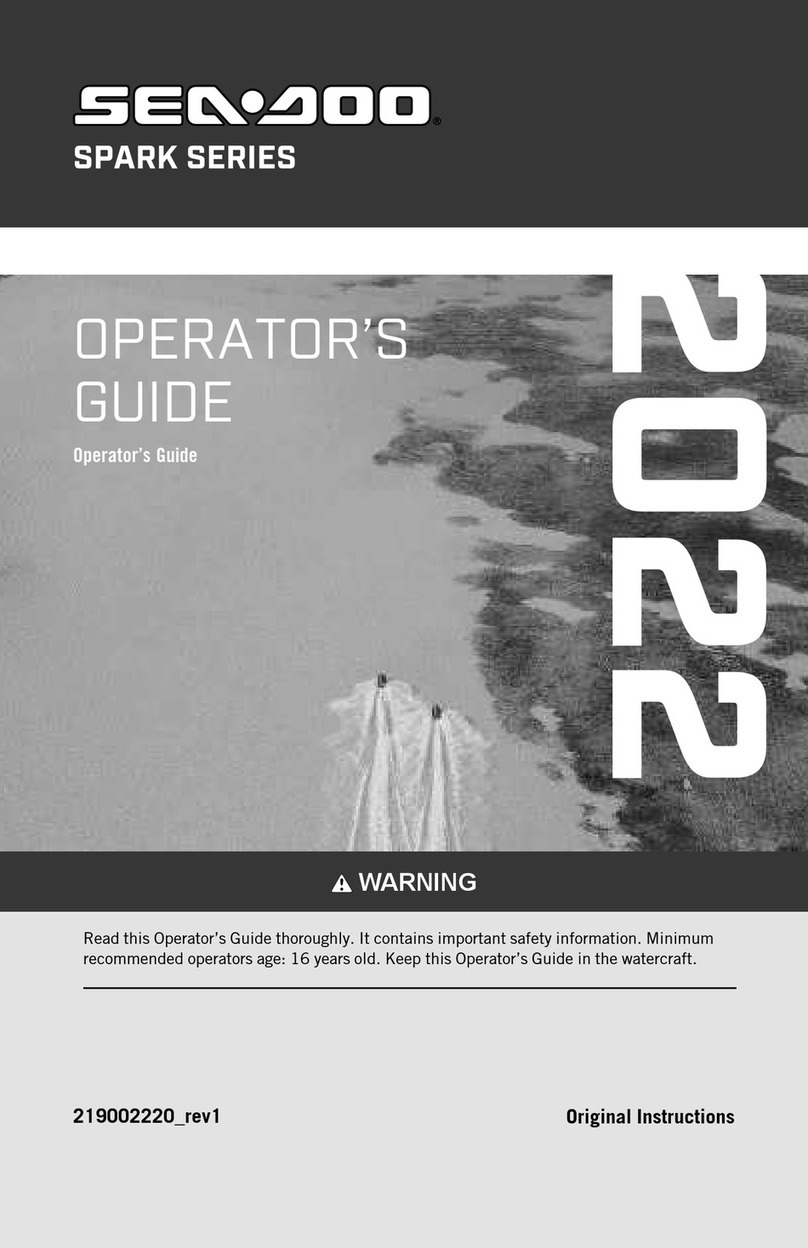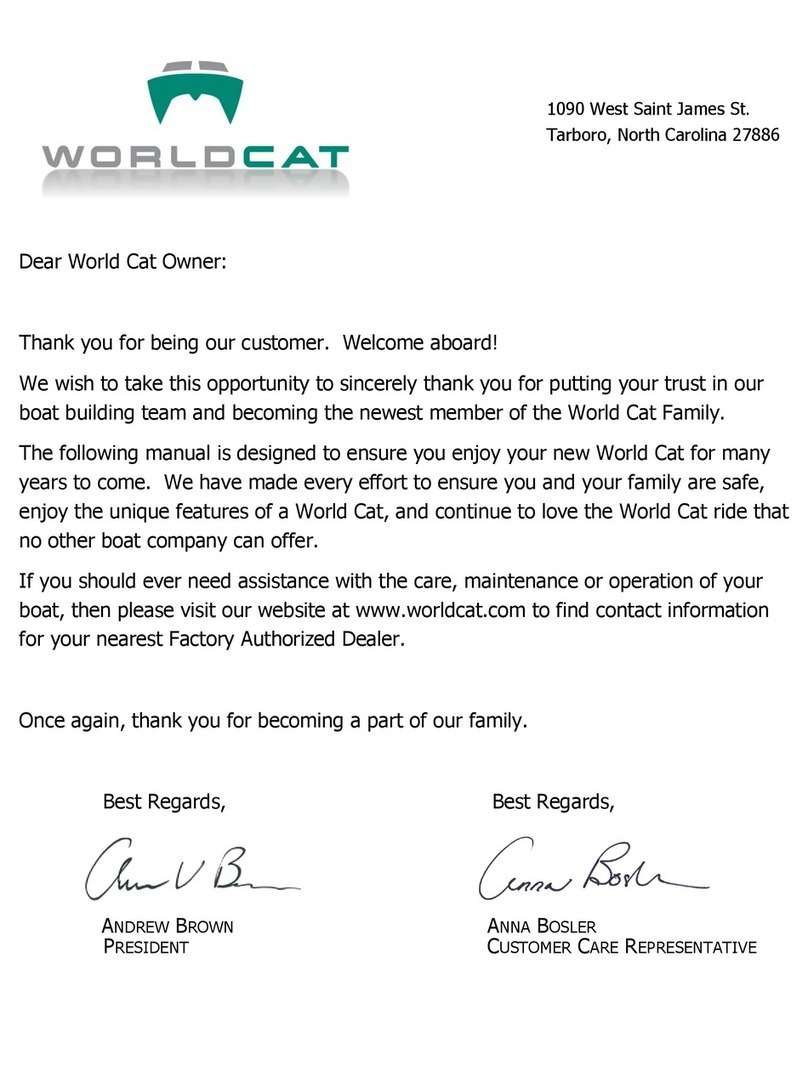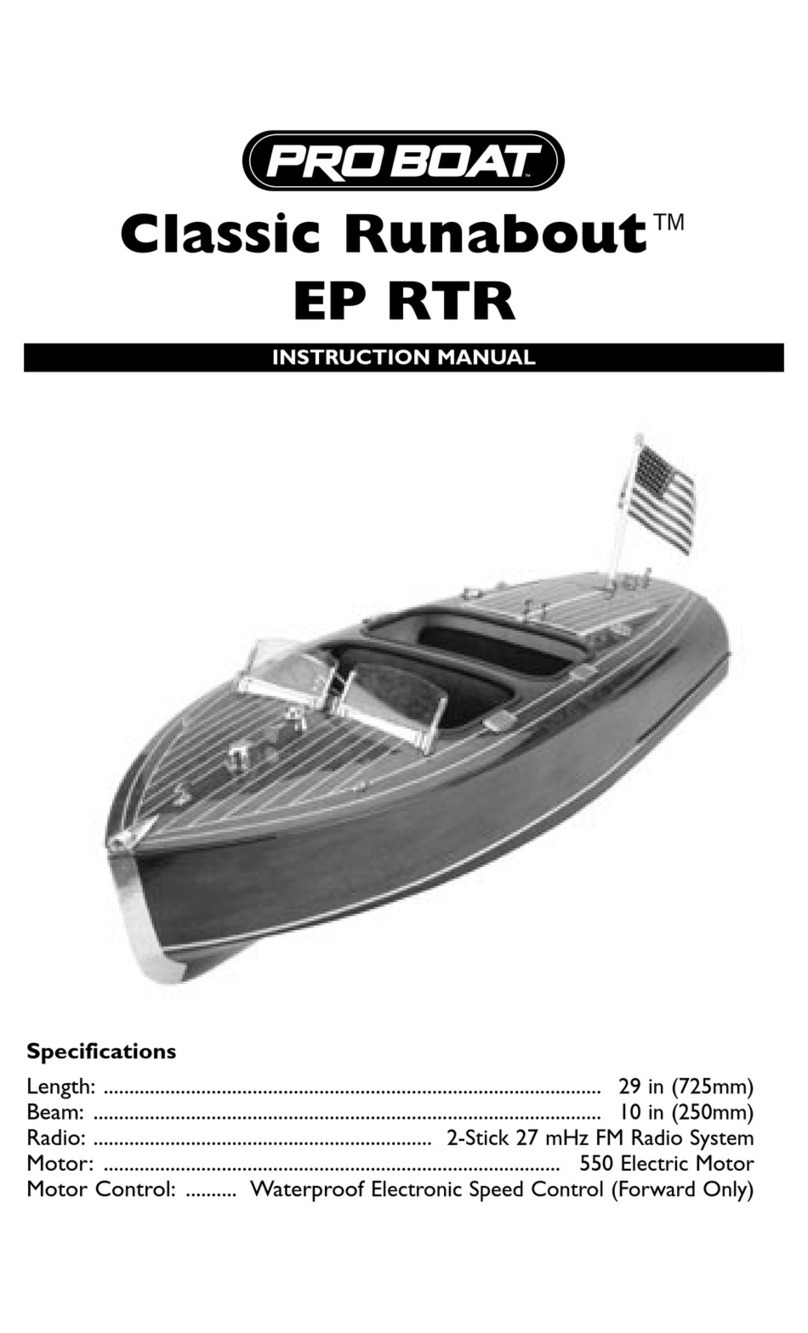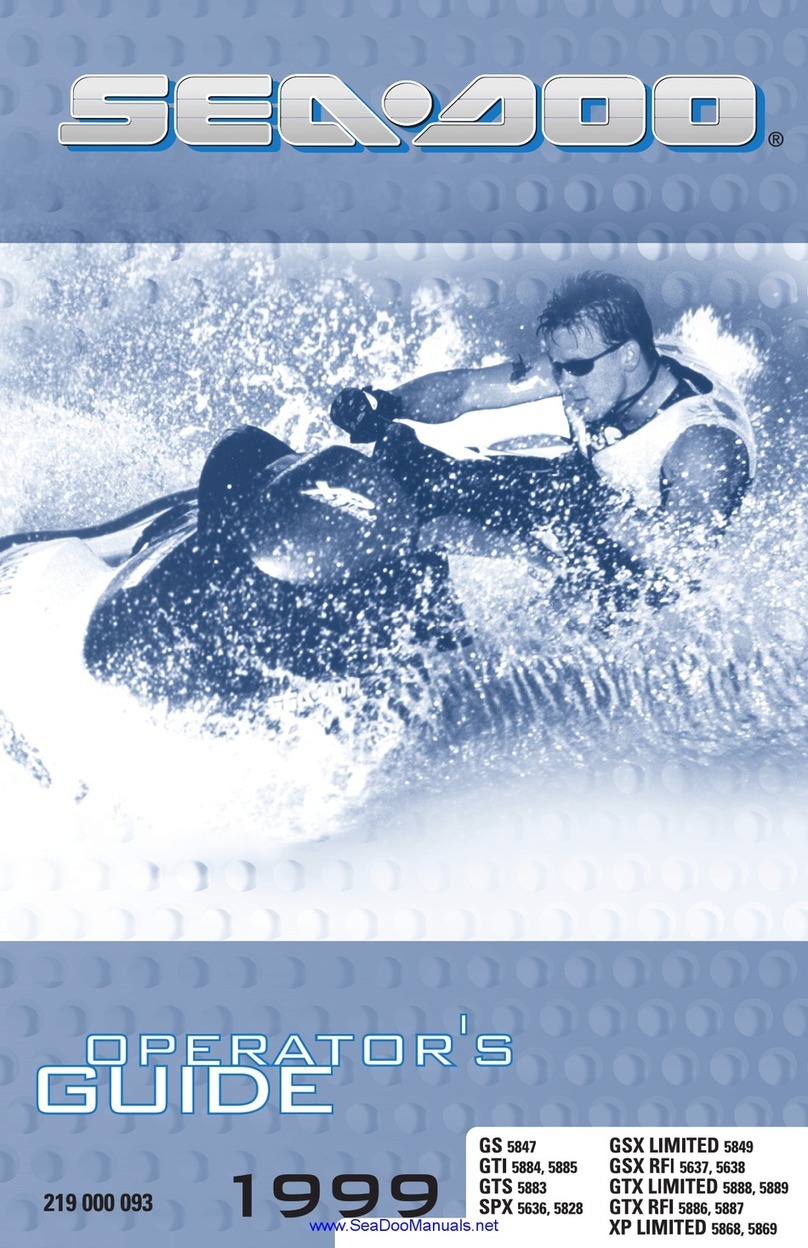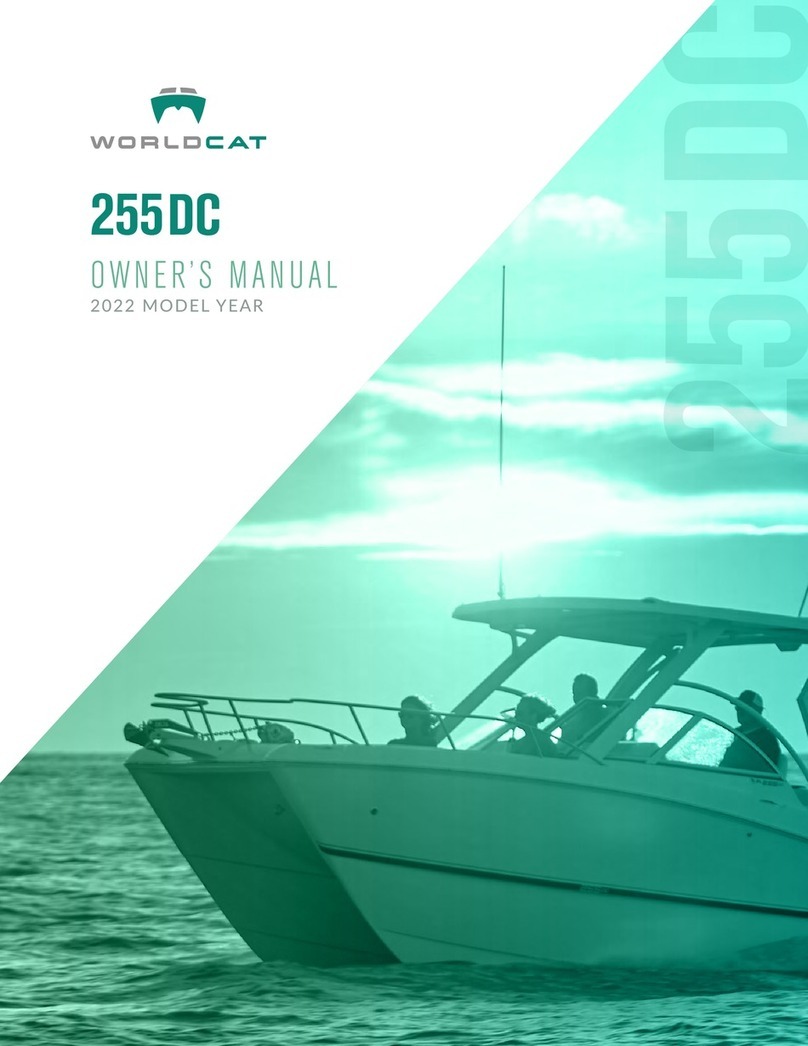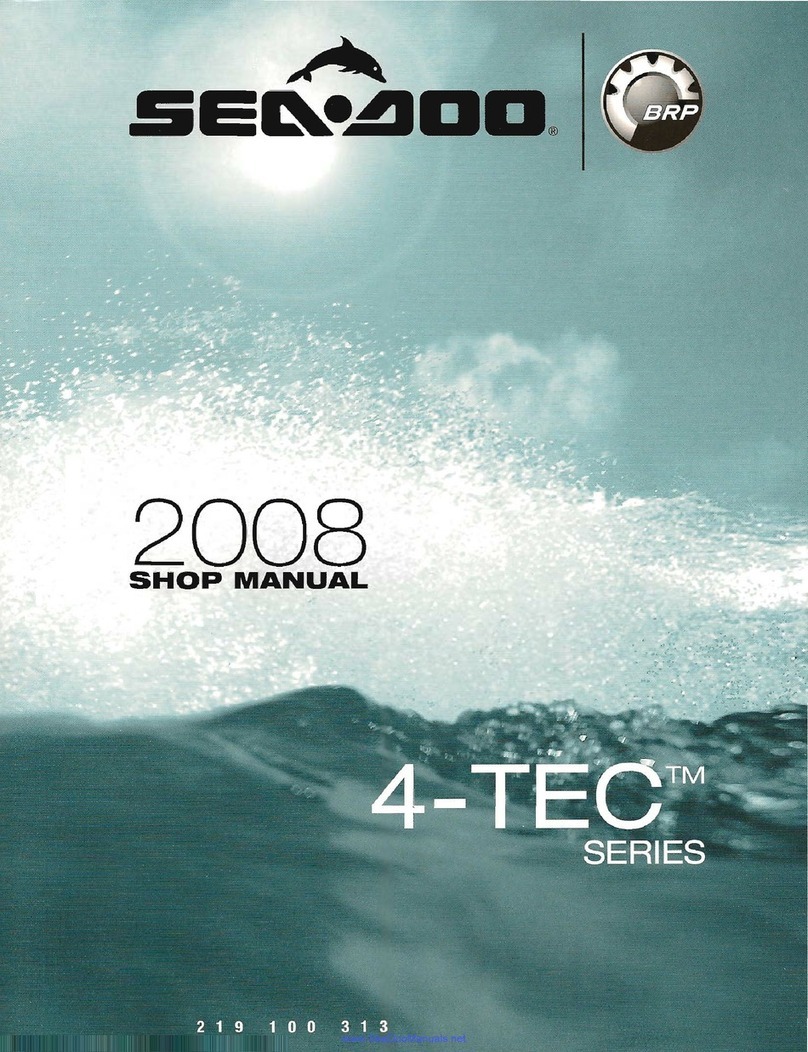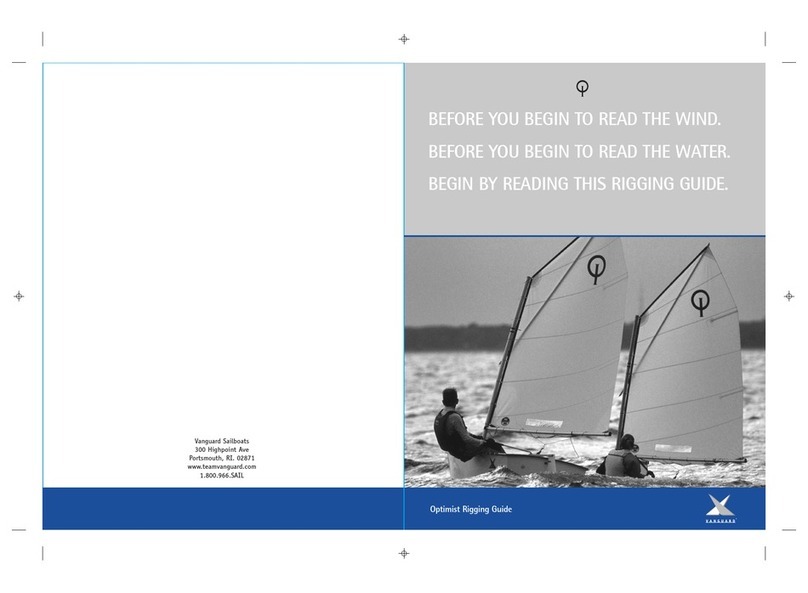Seascape 27 User manual

!
!
OWNER'S MANUAL

2!
!
PREFACE
Dear Seascape 27 owner,
Congratulations with your new Seascape 27. We hope you are going to
enjoy sailing her as much as we enjoyed in her creation. We believe that
the process of discovering her potentials will give you plenty of
satisfaction and fun for many years.
To become fully acquainted with your Seascape 27 and to obtain optimum
performance as well as for your personal safety we suggest dedicating
adequate time to carefully read the Owner’s manual and to follow the set
forth instructions and standards.
The Owner’s manual has been compiled to help you operate your
Seascape 27 with safety and as little complications as possible. It contains
details of the boat and equipment, some safety topics as well as operation
and maintenance hints. Read it carefully and familiarize yourself with the
boat before using it.
Please be advised of the following:
This Owner’s manual is not a course on boating safety or seamanship.
Even if everything has been planned and designed for the safety of the
boat and its users, boating is highly dependent from the weather and sea
conditions, the experience and physical shape of the crew, etc. and one
can never ensure full safety. The sea or the water is not a natural
environment for mankind and one can only respect its laws and its
strength.
Make sure that you are able to handle the boat in the anticipated wind and
sea conditions before venturing out. This boat has been classified as a
category B vessel. The International IMO COLREG regulation defines rules
of way, navigation lights, etc. throughout the world. Make sure you know
these rules and you have a booklet explaining them on-board.
Maintain your boat properly and in good condition. However, make
allowance for the deterioration that will occur in time and understand that
heavy use or misuse of the boat will result in reduced performance.
This Owner's Manual is neither an operation, troubleshooting or
maintenance booklet. Always use a trained professional for maintenance,
fixing or minor modification. For larger modifications ensure that he does
not significantly modify the safety characteristics of the boat. Note also
that any change in the disposition of masses on-board may significantly
affect the stability, trim and performance of your boat. Where relevant,

3!
!
ensure the professional you hired has a written authorisation of the
builder or his legal representative. The builder cannot be held responsible
for modifications that have not been previously approved.
In many countries a driving licence, authorisation or training is required;
please make sure you obtain these legal authorisations before sailing.
Always have a weather forecast or prevision prior to any sailing session or
travel and ensure that the wind and sea conditions will correspond to the
design category of your boat. Ensure that you and your crew are able to
handle the boat in these conditions.
If this is your first boat or you are changing to a type of boat you are not
familiar with, for your own comforts and safety, please ensure that you
obtain handling and operating experience before "assuming command" of
the boat. Your dealer, national sailing federation or yacht club will be
pleased to advise you of local sea schools or competent instructors.
Please note:
-All crew should receive suitable training
-The boat should not carry more than the builder’s recommended
load
-Stability is reduced by any weight added high up
-Hatches must be closed and sealed
-Breaking waves are a serious stability hazard
-Buoyancy aids are recommended to wear at all times by all crew for
their own safety
-While sailing always keep the keel in it’s working (fully down!)
position
Please keep this manual in a dry and secure place and hand it over to the
new owner when you sell this sailing boat.

4!
!
TABLE OF CONTENT
PREFACE!.....................................................................................................................................!2!
TABLE OF CONTENT!..............................................................................................................!4!
1.!GENERAL INFORMATION!...........................................................................................!6!
2.!IMPORTANT INFORMATION!.....................................................................................!7!
2.1.!DEGREES OF DANGER!....................................................................................................!7!
2.2.!LABELS ON BOARD!..........................................................................................................!7!
2.3.!LIABILITY OF THE OWNER/OPERATOR!....................................................................!7!
2.4.!FIRE PROTECTION AND ESCAPE PLAN!.....................................................................!8!
2.5.!PRE-DEPARTURE CHECK LIST!.....................................................................................!9!
2.6.!WATER INTAKE DURING SAILING!.....................................................................!9!
2.7.!CLOSING UP YOUR BOAT AFTER SAILING CHECK LIST!...................................!10!
2.8.!HULL IDENTICATION, BUILDER’S PLATE!...............................................................!10!
2.9.!MAXIMUM TOTAL LOAD!...............................................................................................!11!
3.!TECHNICAL SPECIFICATIONS!................................................................................!12!
3.1.!TECHNICAL DATA!...........................................................................................................!12!
4.!GENERAL ARRANGEMENT!........................................................................................!13!
4.1.!HULL!...................................................................................................................................!13!
4.2.!DECK LAYOUT!..................................................................................................................!14!
4.3.!INTERIOR LAYOUT!.........................................................................................................!15!
4.4.!PROFILE!.............................................................................................................................!16!
5.!PROPULSION SYSTEMS!.............................................................................................!17!
5.1.!RIG!......................................................................................................................................!17!
5.2.!ENGINE SYSTEM (OPTIONAL)!...................................................................................!18!
5.2.1.!ENGINE OPERATION!.............................................................................................!18!
5.2.2.!ENGINE INSTALLATION (OPTIONAL)!.............................................................!18!
5.2.3.!FUEL SYSTEM (OPTIONAL)!................................................................................!18!
6.!SYSTEMS AND CIRCUITS!..........................................................................................!19!
6.1.!BILGE WATER SYSTEM!.................................................................................................!19!
6.2.!CHEMICAL TOILET (OPTIONAL)!................................................................................!19!
6.3.!JET BOIL (OPTIONAL)!...................................................................................................!20!
6.4.!ELECTRICAL SYSTEMS!.................................................................................................!21!
6.4.1.!12V SYSTEM!............................................................................................................!21!
6.4.2.!230V SYSTEM (OPTIONAL)!................................................................................!22!
6.5.!RUDDERS AND STEERING SYSTEM!.........................................................................!23!
6.6.!OPERATING THE KEEL!..................................................................................................!25!
7.!GARBAGE DISCHARGE!...............................................................................................!27!
8.!MAINTENANCE!..............................................................................................................!28!
8.1.!HAULAGE!...........................................................................................................................!28!
8.2.!UNDERWATER STRUCTURE!........................................................................................!28!
8.2.1.!HULL!...........................................................................................................................!28!
8.3.!HULL AND DECK!.............................................................................................................!29!
8.3.1.!CLEANING!.................................................................................................................!29!
8.3.2.!STAINS, SCRATCHES AND ABRASION!..........................................................!30!
8.4.!MAST, SAILS AND RIGGING!.......................................................................................!30!

5!
!
8.5.!DECK EQUIPMENT!..........................................................................................................!31!
8.5.1.!LIFELINES AND STANCHIONS!..........................................................................!31!
8.5.2.!WINCHES AND BLOCKS!......................................................................................!31!
8.5.3.!PLEXIGLASS, PORTLIGHTS AND HATCHES!.................................................!31!
8.6.!INTERIOR!..........................................................................................................................!32!
8.6.1.!INTERIOR WOOD SURFACES!............................................................................!32!
8.6.2.!CUSHIONS!................................................................................................................!32!
8.6.3.!REFRIGERATOR (OPTIONAL)!.............................................................................!32!
8.6.4.!BILGE STRAINERS AND PUMPS!.......................................................................!32!
8.6.5.!FUEL AND WATER TANKS!...................................................................................!32!
9.!WINTERISATION!.........................................................................................................!33!
9.1.!BLOCKING THE HULL!....................................................................................................!33!
9.2.!ELECTRICAL SYSTEM!....................................................................................................!33!
9.3.!ENGINE!..............................................................................................................................!33!
9.4.!SAILS!..................................................................................................................................!33!
9.5.!COVERING!........................................................................................................................!34!
9.6.!CUSHIONS!........................................................................................................................!34!
9.7.!INTERIOR!..........................................................................................................................!34!
11.!INSTRUCTIONS FOR USE OF INSTALLED EQUIPMENT!............................!40!

6!
!
1. GENERAL INFORMATION
Builder:
ISSA d.o.o.
Novo Polje, cesta XI/6
1260 Ljubljana Polje
Slovenia
email: [email protected]
web: www.thinkseascape.com
Model: Seascape 27
CE Category:
B — offshore: A boat designed for offshore voyages where conditions up
to and including wind force 8bft and significant wave heights up to and
including 4 m may be experienced.
A significant wave height is the mean height of the highest one third of
the wave, which approximately corresponds to the wave height estimated
by an experienced observer. Some waves will be double this height.
Maximum Recommended Load:
Category B:
- 6
- 6+ < 810kg
Category C:
- 8
- 8 + <810 kg
Specifications:
Length (LH1) = 7,99m
Width (BH1) = 2,54 m
Mast height (above the deck) = 10,90m
Main sail area = 28m²
Jib area = 21m²
Spinnaker area = 80m²
Maximum draft (standard keel) = 2,0 m with keel down
Maximum draft (standard keel) = 0,95 m with keel up
Ready to sail without crew = 1617 kg
Identification: Hull Identification Number is on the stern of each hull.

7!
!
2. IMPORTANT INFORMATION
2.1. DEGREES OF DANGER
This manual uses the following degrees of danger:
DANGER:
Denotes that an extreme intrinsic hazard exists
which would result in high probability of death or
irreparable injury if proper precautions are not
taken.
WARNING:
Denotes that a hazard exists which can result in
injury or death if proper precautions are not taken.
CAUTION:
Denotes a reminder of safety practices or directs
attention to unsafe practices which could result in
personal injury or damage to the sailing yacht or
components.
2.2. LABELS ON BOARD
Figure 1
2.3. LIABILITY OF THE OWNER/OPERATOR
Before sailing, the boat owner/operator should read this manual and
familiarize himself/herself with its contents, in particular with all the
warnings relating to safe use and emergency procedures. It is the
responsibility of the owner to ensure that, when sailing, the sailing boat is
equipped with all the (safety) equipment required under the law of the
countries he is sailing in. The owner/operator shall also inform all other

8!
!
crew members about the proper use of the boat and equipment and the
emergency procedures.
2.4. FIRE PROTECTION AND ESCAPE PLAN
This sailing yacht is equipped with portable fire extinguisher of the
following extinguishing capacity and at the following location: (see Fig. 2)
No.
Location
Capacity
1
Under left berth in the main cabin
1 kg
2
Next to the toilet
1kg
In case of need for evacuation, use the following escape route:
Figure 2
It is the responsibility of the boat owner/operator to:
•Have the fire-fighting equipment checked at the intervals indicated on
the equipment,
•Replace the fire-fighting equipment, if expired or discharged, by
devices of identical or greater fire-fighting capacity,
•Inform crew members about the location and operation of the fire-
fighting equipment and the location of the escape routes,
•Ensure that the fire-fighting equipment is readily accessible when the
boat is occupied.

9!
!
WARNING:
NEVER obstruct passageways to exits and hatches.
NEVER obstruct safety controls, e.g., switches of electrical
system.
NEVER leave the boat unattended when cooking appliances
are in use.
NEVER use gas light in the craft.
DO NOTmodify any of the boat’s systems (especially
electrical).
NEVER smoke while handling fuel or alcohol.
DO NOT fit fabrics in the vicinity of or above the cookers or
other open flame devices.
DO NOT store combustible material in the engine
compartment.
2.5. PRE-DEPARTURE CHECK LIST
1. Close the hatches,
2. Switch on the main electrical switch,
3. Switch on navigation lights if necessary,
4. Check the navigation lights,
5. Check if the bilges are clean and if the bilge pump operates properly,
6. Check the required safety equipment,
7. Check the position of all the inlet/outlet seacocks in the hull if present.
2.6. WATER INTAKE DURING SAILING
If you notice water in the boat while sailing, stay calm and immediately
check if all seacocks are closed. To pump the water out use the manual
bilge pump. Try to find out the cause of the leak as quick as possible. If
you fail to find the cause and if the water level in the craft continues to
raise start evacuation procedures.
If you run aground while sailing, check for any leaks at the keel screws
and inspect for the structural damage on the hydraulic system. The keel is
equipped with a safety valve which will release the pressure, allowing the
keel to swing back. When the depth allows, immediately return the keel in
the full down position.
WARNING:
ALWAYS sail with keel fully down!
In case of a leak, follow the directions in the previous paragraph and have
the sailing boat lifted from water as soon as possible.

10!
!
2.7. CLOSING UP YOUR BOAT AFTER SAILING CHECK LIST
1. Turn off the electrical system,
2. Close all the portlights and hatches,
3. If present, close all inlet/outlet seacocks in the hull,
4. If present, turn off the valve on the jet boil.
2.8. HULL IDENTICATION, BUILDER’S PLATE
The boat has on the stern a plate with Hull Identification Number (HIN)
visible on the starboard side of the transom.
S
I
-
S
S
C
2
7
x
x
x
X
x
1
2
Country code
Manufacturer’s identification
Serial Number
Month of manufacture (letter: January=A, February=B etc.)
Year of manufacture (last numeral)
Model year
The duplicate HIN plate is fastened on inner hull structure.
The builder’s plate is readily visible, located on the stern, with the
following information:
•Builder’s name.
•The CE mark followed by the identification number of the notified body
("0098" for "Germanischer Lloyd").
•The design category: !A !B !C !D
•The number of persons recommended by the builder for which the boat
is designed to carry when underway.
•Builder´s recommended load.

11!
!
Figure 3
2.9. MAXIMUM TOTAL LOAD
Keep the total weight of the boat, miscellaneous equipment not supplied
by the builder, and persons on board below maximum of total load and
suitably distributed.
manufacturer: Issa d.o.o.
type: Seascape 27
max.: 6 B cat.
max.: 8 C cat.
max. load: + 810 kg
max. kW./HP: 8/10
category: B

12!
!
3. TECHNICAL SPECIFICATIONS
3.1. TECHNICAL DATA
Boat Type
Seascape 27
Boat Class
Sailboat
Boat Design Category
B “Offshore”
HIN
SI-SSC 27 xxxXx 12
Manufactured by
Issa, d.o.o.
Novo Polje XI/6,1000 Ljubljana,
Slovenia
Certification
EC Type Examination Module Aa
Certificate record No.
88011350
Notified body
GERMANISCHER LLOYD AG
Head office
Brooktorkai 18, D-20457 Hamburg,
Germany
Length over all
7,99 m
Hull length
7,99 m
Length at waterline
7,95m
Beam max.
2,54 m
Draft
2,00/0,90 m
Air draft
12,20 m
Ready to sail without crew
1617 kg
Manufacturer’s recommended
load
810 kg
Displacement max.
2507 kg
Ballast
600 kg
Outboard engine max. (optional)
8,0 kW / 10hp
Fuel capacity (optional)
25 litres
Water capacity (optional)
55 litres
Maximum crew
B category:6 persons
C category:8 persons
Cabins
1
Berths
2 + 4
Mainsail
28 m2
Jib
21,00 m2
Gennaker
80,00 m2
I
10,90 m
J
3,73 m
P
10,00 m
E
3,70 m
Design
Samuel Manuard

13!
!
4. GENERAL ARRANGEMENT
4.1. HULL
Figure 4

14!
!
4.2. DECK LAYOUT
Figure 5
WARNING:
Keep washboards, doors and hatches closed when
appropriate, e.g. in rough weather or at higher sailing
speeds.
Secure unfixed equipment safely when underway.
If a liferaft shall be fitted, recommended place is on the
stern. Strictly follow the instructions of the liferaft
producer.

15!
!
4.3. INTERIOR LAYOUT
Figure 6
Interior profile:
Figure 7

16!
!
4.4. PROFILE
Figure 8

17!
!
5. PROPULSION SYSTEMS
5.1. RIG
Figure 9

18!
!
5.2. ENGINE SYSTEM (OPTIONAL)
CAUTION:
Follow the instructions supplied by the engine producer,
especially with regards to the RPM and load of a new
engine.
When shifting from one gear to another via the idle
position, keep the handle in the idle position long enough
for the engine to rotate at the minimum RPM. When putting
in the reverse, hold the steering tiller firmly to avoid
breaking the steering system.
Check the engine oil level regularly.
Shut down the engine before putting it into storage
position. The engine has rotating and moving parts that
can be dangerous.
5.2.1. ENGINE OPERATION
For detailed information see the operation instructions, written by the
engine producer. Before operating the engine you should familiarize
yourself with those instructions.
CAUTION:
When sailing with inclination over 20 degrees, stop the
engine.
Make sure that the tank will at all times be filled over 10%
of its capacity.
5.2.2. ENGINE INSTALLATION (OPTIONAL)
The standard version of Seascape 27 is not equipped with an engine
system. The engine is to be installed into the central cockpit box.
WARNING:
Do not obstruct any fuel lines (possible damage).
Do not put flammable material in contact with hot engine
parts.
5.2.3. FUEL SYSTEM (OPTIONAL)
The fuel required for optional engine operation is stored in a fuel tank. The
fuel tank has a capacity of 12 liters. The fuel tank is stowed and accessed
in the central cockpit box.
DANGER:
When filling the tank, turn off the engine. At the time
of filling do not smoke or use any substance or item
which could cause flame.

19!
!
6. SYSTEMS AND CIRCUITS
6.1. BILGE WATER SYSTEM
Figure 10
CAUTION:
Check the bilge pump for bilge water before leaving the
dock, during sailing and when leaving the boat for a longer
period.
Follow carefully the instructions for use and precautions
marked on the pump.
6.2. CHEMICAL TOILET (OPTIONAL)
As an option portable chemical toilet can be installed in the separated
compartment between the two bulkheads. If not supplied by the builder,to
prevent any over spillage and other malfunctions make sure the
installation is firm and according the instructions of the manufacturer.
CAUTION:
To make the most of new portable chemical toilet, read the
instructions carefully and keep them for consultation in the

20!
!
future.
The instructions are supplied together with thisowner’s
manual or, if installed additionally, directly from the
manufacturer.
DO NOT over fill the tanks.
DO NOT put any detergents into the upper tank.
6.3. JET BOIL (OPTIONAL)
The boat is optionally equipped with a jet boil.
CAUTION:
Carefully read and understand the instructions, before
using your jet boil.
The instructions are supplied together with this owner’s
manual or, if installed additionally, directly from the
manufacturer.
WARNING:
You must always be extremely careful when operating jet
boil. Keep in mind at all times that you are operating with a
bare flame. To avoid fire risks or burning the instructions
are to be followed carefully.
DANGER:
Avoid asphyxiation. Provide ventilation when the jet
boil is in use.
DO NOT use for space heating.
DO NOT smoke or use open flame when using the jet
boil or recharging a gas canister.
•Assure that the jet boil is mounted properly. Eventual repairs must be
done by qualified persons. Ask your wholesale or retail dealer.
•Wear proper clothes when you use the jet boil, in order not to catch
fire.
•Assure that all parts of the jet boil are cold before touching them:
when the burner is turned off, some parts are still hot enough to
provoke burns.
•Make sure that the jet boil is cleaned well, especially around the
burners.
•Keep children at a safe distance; if not with an adult, do not permit
them to get close to any part of the jet boil, while it is operating.
•Never use the jet boil as a heating system for places or people.
•Never use the jet boil unguarded while you are using it: an unexpected
event may cause damage to things or people.
•Avoid that clothes, or any other inflammable material, make contact
with the burners, before they are adequately cooled.
•Never leave plastic or wooden utensils near the jet boil during use.
Table of contents
Other Seascape Boat manuals


